
Searching for the remnants of Edo’s oldtown legend, Hokusai. (Part 3)

Hello, this is Ontama Negitoro. Following up on the previous article, this time I will explain key points to keep in mind when using buses and provide information about accommodation options.
*As of August 2024
Table of Contents
2. Rules and Conditions for Domestic Bike Travel
2-6. Buses (Express Buses, Airport Shuttle Buses)
2-7. Buses (Local Buses)
2-8. Airplanes
3. Bicycle Travel Acceptance / Accommodation Options
4. Conclusion
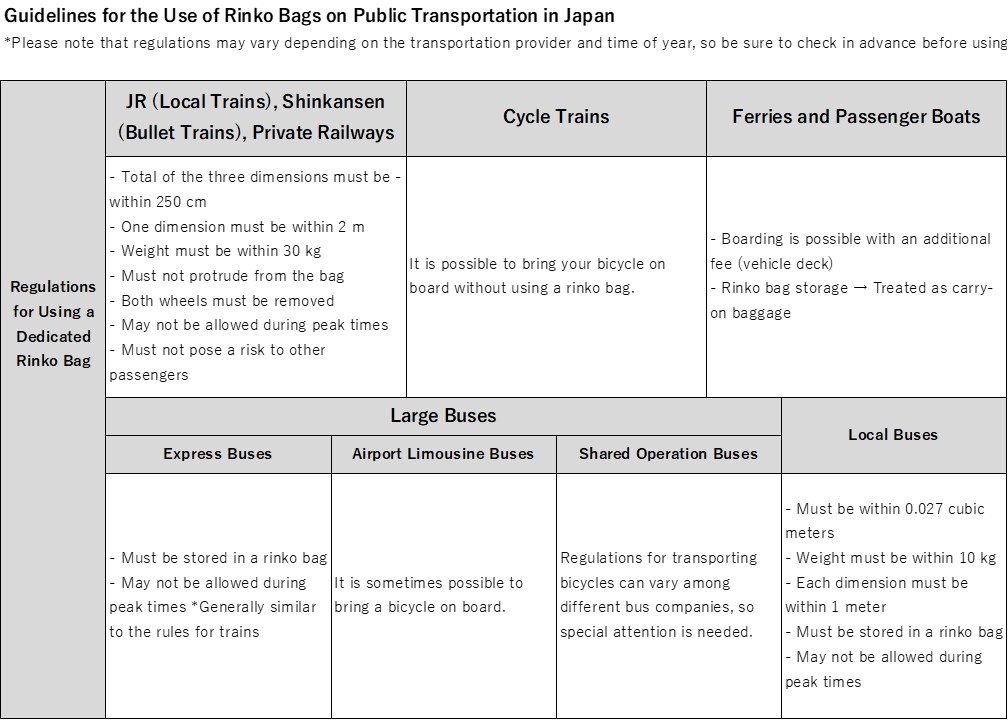
Express Buses
< Regulations for Using a Dedicated Rinko Bag >
– Bicycle must be stored in a rinko bag
– May not be allowed during peak times due to limited space
In most cases, the rules are similar to those for trains. Some bus companies may allow bicycles if they are stored in a rinko bag, so it’s important to check the regulations of the specific bus company you plan to use.
< Bicycle Travel by Bus >
Currently, long-distance travel with bicycles on buses in Japan is somewhat challenging. Although several express bus companies used to allow bicycles, many of these services have been discontinued. Therefore, when planning to travel by bus with your bicycle, be sure to carefully check the regulations of the relevant bus line, and if necessary, contact the bus company directly for confirmation.
As of 2024, most long-distance buses, including express and intercity buses, no longer accept bicycles.
Additionally, the regulations often include the following conditions:
– The bicycle must be stored in a rinko bag
– It may not be allowed during peak times due to limited space
Since buses have limited space in their luggage compartments, it’s important to pack your bicycle as compactly as possible. Generally, some buses with luggage compartments may allow bicycles in rinko bags. In cases where intercity rail services have been reduced or discontinued, buses often serve as the main transportation option in those areas, and bicycle travel may be allowed more frequently.
In areas like Hiroshima or on routes connecting cities in the Tohoku region, it’s still possible to travel with a bicycle on buses, so it’s worth checking those routes.
References:
– Hiroshima Bus Co., Ltd.: “Are there any restrictions on bringing luggage onboard?”
– Iwate Kenpoku Bus: “User Guide”
Airport Shuttle Buses
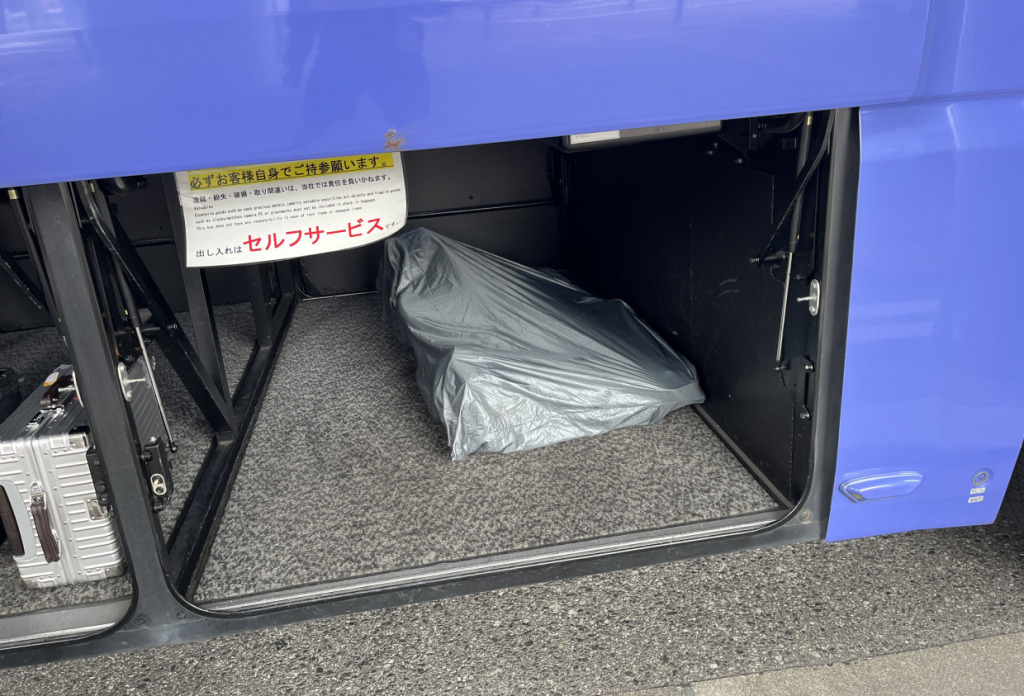
In some cases, you can take your bicycle on an airport limousine bus. This is often the case when the airport is located far from the nearest train station and the bus serves as the main form of transportation.
However, as I will explain in the “Jointly Operated Buses” section, caution is required for joint operation services.
– Bicycle transport possible: Hiroshima Airport Limousine Bus
– Bicycle transport not possible: Akita Airport Limousine Bus
< Jointly Operated Buses >
When multiple bus companies operate a route jointly, the regulations for carrying bicycles can vary between the companies. Therefore, extra caution is needed.
For example, on the route between Matsue and Hiroshima, Ichibata Bus operates in the morning and Hiroden Bus operates in the afternoon. While bicycle transport may be allowed on Hiroden Bus, it might not be permitted on Ichibata Bus.
References:
– Hiroshima Electric Railway Co., Ltd.: “Request to Customers”
– Ichibata Bus Co., Ltd.: “User Guide”
< Regulations for Using a Dedicated Rinko Bag >
– Within 0.027㎥
– Weight under 10 kg
– Each dimension within 1 meter
– When stored in a rinko bag
– May not be allowed during peak times
*These regulations are generally more suited for folding bikes rather than standard road bikes.*
< Bicycle Travel on Local Buses >
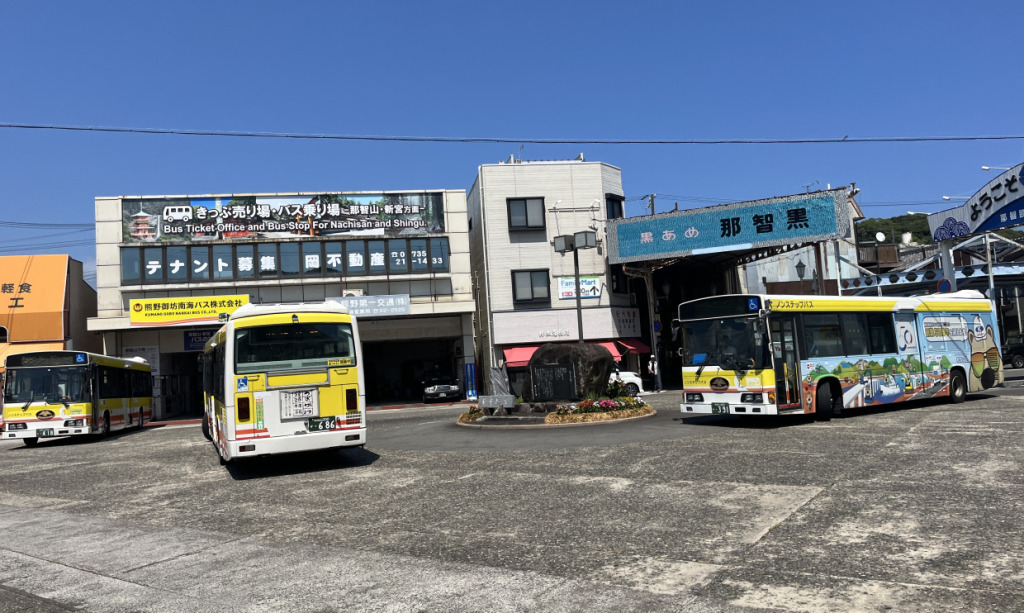
For bicycle travel on local buses, the regulations are often as follows:
– Within 0.027㎥
– Weight under 10 kg
– Each dimension within 1 meter
– When stored in a rinko bag
– May not be allowed during peak times
Based on the Ministry of Land, Infrastructure, Transport and Tourism’s guidelines, many companies have established regulations that often include the size limits mentioned above, even if they allow bicycle transport.
For example, the vertical rinko bag OSTRICH L-100, typically used for road bikes, measures H1.1×W0.95×D0.25 meters, which calculates to about 0.26㎥. This exceeds the typical size limit, making it unsuitable for local buses. Therefore, these regulations are generally designed for folding bikes.
While there are rare cases where road bikes have been allowed on local buses in emergencies, it is recommended to operate under the assumption that local buses generally do not accommodate bicycles and to plan accordingly for your cycling trips.
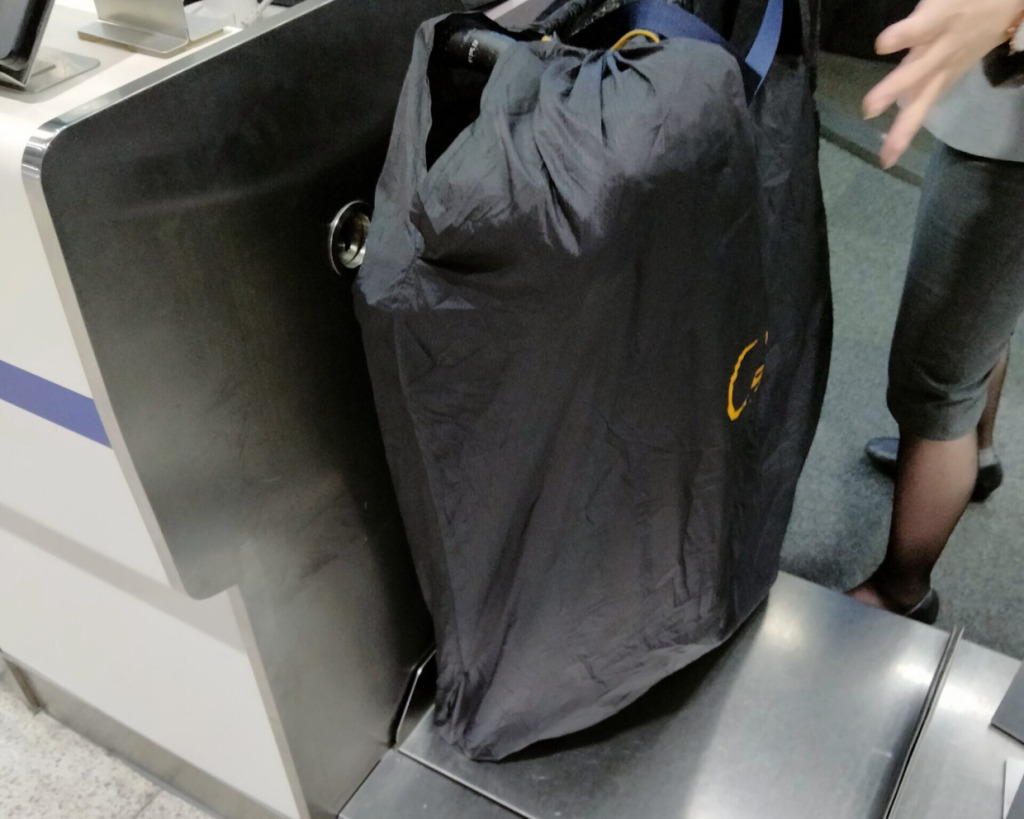
Just like with international flights, you can bring bicycles on domestic flights as well. For basic precautions and characteristics, please refer to the article on traveling with bicycles on international flights.
The Bike Travel Professional’s Guide:International Edition (japanese text only)
When participating in a road bike event, you often need to arrange hotel accommodations during the event period. While this is slightly different from bike travel, I will also cover information about bicycle acceptance at lodging facilities.
For example, HOTEL AZ, which operates in the Kyushu, Chugoku, and Shikoku regions, offers a bicycle room entry service.
The AZ HOTEL chain, HOTEL AZ, is friendly to cyclists.
This indoor bicycle entry service is very convenient for those preparing for cycling events, and I have used similar services at other hotels myself.
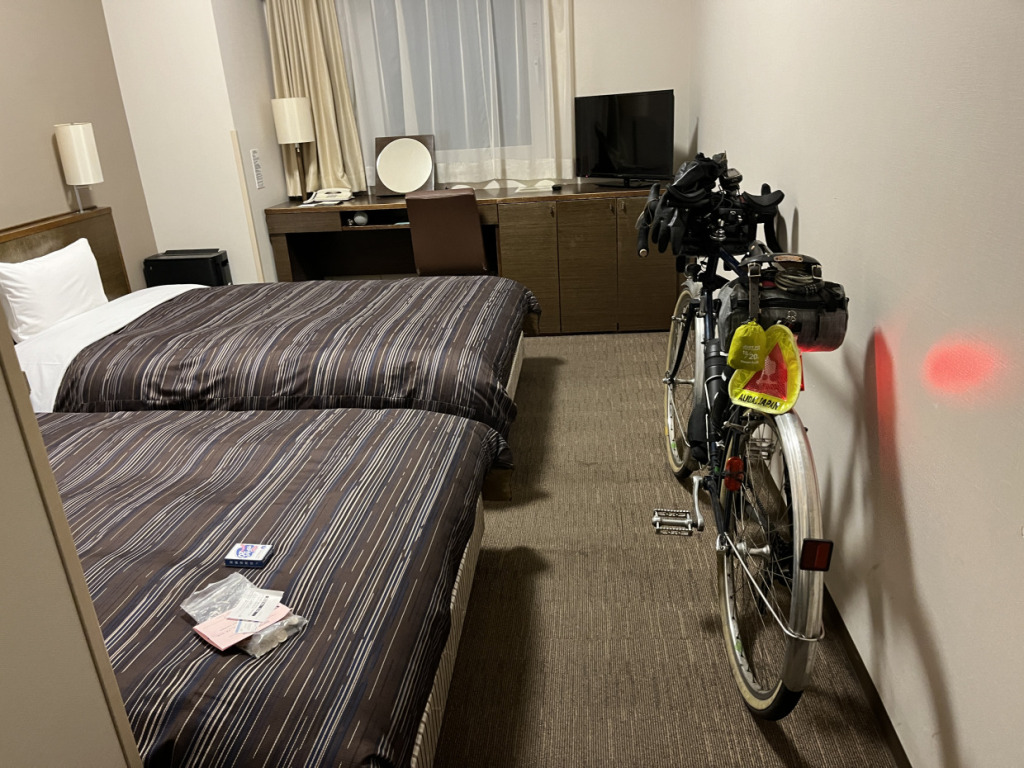
The experience is “quite convenient.” First, you don’t have to worry about bicycle theft. As someone who tends to be anxious, I sometimes find myself having a restless sleep the night before an event if my bike is left in a hotel parking area.
Bringing your bike into your room also makes morning preparations smoother. You can pack everything you need up until the last minute and be ready to ride as soon as you step out of the hotel entrance, ensuring a seamless transition to your cycling activities.
If this service becomes more widespread across hotels nationwide, it would make participating in cycling events across the country even easier. Be sure to check with your hotel about their bike policy—you might be pleasantly surprised by their willingness to accommodate you!
In this article, we’ve explored various ways to combine transportation and cycling within Japan. If you’re attending domestic events, there will likely be times when you’ll need to use a bike bag for transport. Start by practicing how to pack your bicycle into the bag! Once you’re comfortable, you can freely combine trains, planes, and ferries to participate in domestic events. Enjoy your cycling events with smooth bike transport!
Nice ride!
References:
– **Kinu Bicycle Manufacturing** – History & Bike Transport
– **Cyclabo** – Summary of Bicycle Transport Rules for Various Railways
– **JR Hokkaido** – Frequently Asked Questions
– **JR East** – Can you bring large items like bicycles on the train?
– **JR Central** – Ticket Rules
– **JR West** – Ticket Rules
– **JR Shikoku** – Bringing Bicycles on Trains
– **JR Kyushu** – Ticket Rules
– **JR Central** – Rules for Bringing Large Luggage on Tokaido, Sanyo, and Kyushu Shinkansen
– **JR Travel Network** – Kinki Line Cycle Train
– **MOL Ferry** – Sunflower Ferries
– **Tsugaru Strait Ferry**
– **Onomichi Town Public Relations Office** – Station Front Ferry
– **Hiroshima Bus Co., Ltd.** – Restrictions on Carrying Luggage
– **Iwate Prefecture Kitabus** – User Information
– **Hiroshima Electric Railway Co., Ltd.** – Request to Customers
– **Ichibata Bus Co., Ltd.** – User Information
– **Global Ride** – Bike Transport Guide (International Edition)
– **AZ HOTEL Chain** – Hotel AZ: Bicycle-Friendly Hotels
Text_Ontama Negitoro
🚲Articles by Ontama Negitoro
The Bike Travel Professional’s Guide Series
● Domestic Japan Edition 01
● Domestic Japan Edition 02
Gravel Enthusiasts Ride Ancient Routes
● Kii Mountain Range, Kumano Kodo, Off-Road
● Kumano Sanzan Pilgrimage, Exquisite Tuna, Cycle Train
Riding the 1000km Around Shikoku
● An Ultra-Distance Journey by a Gravel Enthusiast
Why Travel to Cape Soya by Bicycle?
● Welcoming the New Year at Japan’s Northernmost Point
Watch Out for Makibishi (Caltrops) !
● A Short Cycling Trip to the Ninja Village
To Taste Mackerel at Wakasa Bay!
A Parent-Child Ride Along the Saba(Mackerel) Kaido
Profile

Ontama Negitoro
Hailing from Sakai City, Osaka Prefecture, Onsen Tamago Negitoro is a company employee, writer, and the administrator of the blog “Bicycle Travel Research Society.” They have been involved in bike camping tours from a young age, having traversed almost all of Japan’s prefectures. During their university years, they were part of a bicycle club and visited over 10 countries solo by bicycle. With extensive experience in bike travel, they undertook an extreme bike camping tour across Hokkaido during the harsh winter of 2023. Recently, they have focused on long-distance rides, earning the SR title in a brevet in 2023 and completing a 1900km brevet during the 2024 Golden Week. They aim to complete PBP and LEL in the future and are also planning to actively pursue overseas bike camping tours.
Post Date:2024.09.20